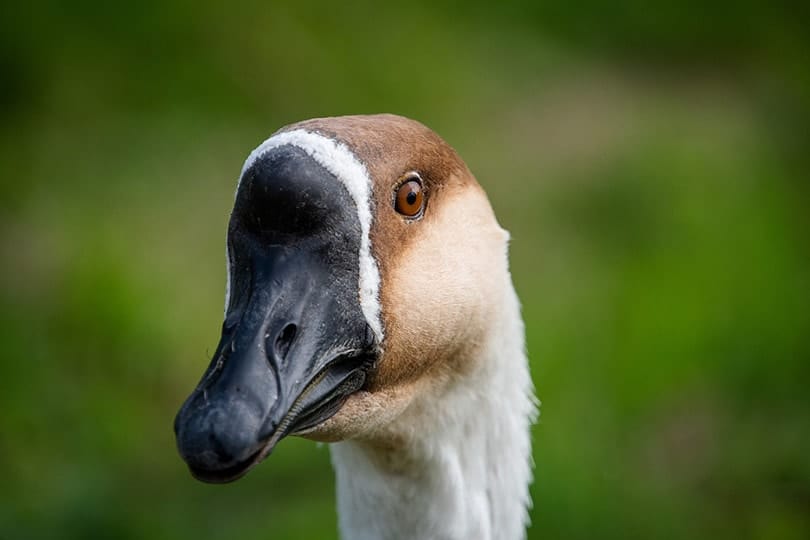If you’ve ever seen a goose with a big knob on its beak, you’ve probably seen a Chinese goose. These geese are some of the most common domestic waterfowl, and for good reason. Great for eggs, weeding, and meat, Chinese geese are a well-rounded addition to any farm. Read on to learn more about the wonderful Chinese goose.
Click to Skip Ahead:

Quick Facts about Chinese Goose
| Breed Name: | Chinese goose, weeder goose, swan goose |
| Place of Origin: | Asia |
| Uses: | Eggs, meat, weed control |
| Gander (Male) Size: | 12 pounds |
| Goose (Female) Size: | 10 pounds |
| Color: | White or brown and white |
| Lifespan: | Up to 20 years |
| Climate Tolerance: | All climates (requires shelter in freezing weather) |
| Care Level: | Low |
| Egg Production: | 40-100 eggs |
| Meat Production: | 8-12 pounds |
Chinese Goose Origins
The Chinese goose is a domestic goose descended from the wild Swan goose. Chinese geese first originated in Asia, although it is unknown which part of Asia. It has a long history in the US—in fact, George Washington owned a pair! Today, it is known for its beauty, high egg production, and ability to eat all kinds of weeds.

Chinese Goose Characteristics
Chinese geese are graceful, elegant birds that are among the smallest geese. They eat a mixed diet of grasses, weeds, and other plants. If you have a large grassy area for your flock to forage, they might not need additional food. In the winter or a smaller space, waterfowl pellets can be substituted instead.
Chinese geese are very social. They often imprint closely to humans and do well in mixed flocks with ducks and other breeds of geese.
Chinese geese hatch clutches of about six eggs naturally, but many breeders use incubators to hatch at a much greater scale. If breeding Chinese geese, you will need one gander for every four to six geese.
Uses
Chinese geese are best suited for egg production and weed control, but they are also sometimes used as meat geese. The Chinese goose is a prolific egg layer. Most geese lay around 60-80 eggs a year, although this might be as low as 40 and some geese lay as many as 100!
Chinese geese are sometimes called “weeder geese” as they are often used to eat grass and weeds. Weeder geese do best in fields and orchards with only one crop type to make training easier.
Meat and down are often byproducts of Chinese geese, not the main goal. Chinese geese are smaller birds that have a reputation for less greasy meat than other waterfowl.
Appearance & Varieties
Chinese geese are easily recognized because of their knobby beaks and graceful appearance. Adult Chinese geese develop a knob at the base of their beak that is larger in males than in females. Chinese geese have long, graceful necks that meet the body at a 45-degree angle.
There are two main varieties of Chinese goose. White Chinese geese are white all over, with bright orange beaks and feet. Brown Chinese geese have dark brown beaks, brown backs, fawn-colored sides, and a light belly. Goslings are bright yellow for the white variety and yellow and gray for the brown variety.

Distribution
Chinese geese can be found all over the United States and in many other parts of the world. They are tolerant of most weather above freezing temperatures. In colder climates, providing shelter will be necessary to keep them from freezing.
Although Chinese geese do not need a pond to thrive, they do need fresh drinking water that is at least four to six inches deep. They enjoy bathing and playing in water, so a trough or kiddie pool will help them keep clean and stay happy.
- Related Read: 13 Fascinating Facts About Geese You Never Knew

Are Chinese Geese Good for Small-Scale Farming?
Chinese geese are some of the most common birds for small-scale farmers because of their small size, easy care, and prolific egg-laying. Chinese geese are social creatures that do well with a flock of ducks or at least one other goose. One drawback to Chinese geese is that they are very noisy birds. In smaller backyard farms, they might bother neighbors, so a few acres of space is ideal.
Overall, the Chinese goose is a great multi-purpose breed for first-time goose farmers. Chinese geese are some of the most prolific egg layers and have many other great uses. You’ll fall in love with this friendly and useful bird!
Featured Image Credit: Camera-man, Pixabay
